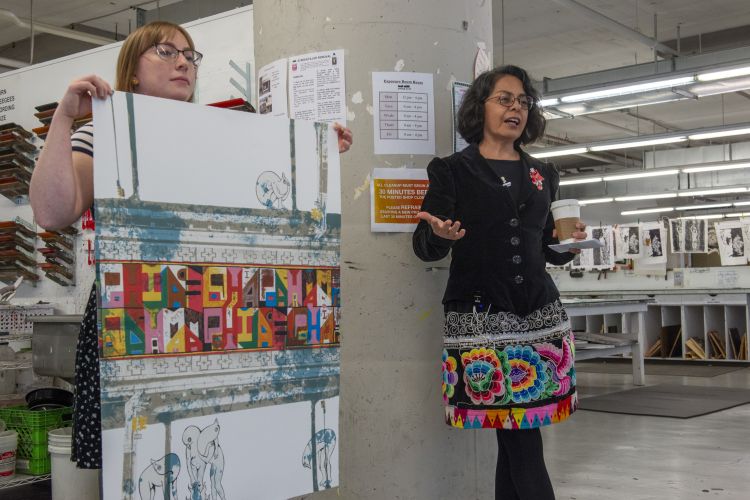STORIES FROM PAFA
The Evolution of Printmaking and Young Artists
Professors and faculty members see their students grow as artists and as people during their time at PAFA.
“It is so interesting to see the evolution of a student over their four year period,” said Printmaking chair Tony Rosati.
He compares the students and artists he meets to salmon, fish who are determined to swim against the tide to achieve their goal.
“Anyone who has a particular calling to a certain profession is in a way like a salmon, and one of the attributes of a salmon is that they are compelled to swim upstream no matter what,” he said, adding that a career as an artist is not always easy.
The idea of salmon as a metaphor for artists has even found its way into Rosati’s own work. His series on animals include the etching We Are Salmon.
“I titled it We Are Salmon for what it means to me and what it means to the students,” Rosati said. “I also started doing birds and had this concurrent thought, ‘We are artists, we are birds’ because we are free to fly with our images in whatever way we want to.
In the thirty plus years Rosati has led the Printmaking Department at PAFA, he’s seen students struggle and eventually fly in their work.
“Sometimes for the people who seem to struggle the most, all of a sudden everything clicks and comes together one day,” he said. “There are many possibilities and sometimes a student clicks with the right thing and you never know and that becomes a very pleasant surprise.”
Rosati has not only seen students in the Printmaking Department flourish, but the program itself has developed and grown over three decades.
He began teaching screenprinting and etching at the PAFA before there was an official printmaking department. In 1985 the department was established, with Rosati leading the new major and introducing more classes for students.
“I introduced the course Print Media and it became a kind of fluid course about eraser stamp prints, letterpress book structures, color reduction linoleum cuts and other mediums,” he said. “The course became a project driven course where students had to make something within each medium.”
Rosati himself works in several different mediums and encourages students to explore. He came to printmaking in an almost accidental way. While waiting in line to register for a class for graduate school, Rosati overhead two fellow students talking about printmaking.
Their conversation piqued his interest and set in motion a lifelong career and passion. Rosati completed his MFA in printmaking at Tyler School of Art at Temple University and spent nine years as the assistant to the curator for the Lessing J. Rosenwald Collection. The Lessing J. Rosenwald Collection parallels the history of Western printmaking from 1400 to the present and consists of 24,000 prints, 2,000 rare books, 2,000 drawings and 4,000 reference books. The collection is now held at the Library of Congress.
His work has been exhibited at Woodmere Art Museum, Artists’ House Gallery, and Peng Gallery among other venues.
Rosati found printmaking almost by happenstance. He said PAFA’s Foundation Year program helps students find their path in a more purposeful way.
“The first year challenges the students to be involved in all different sets of disciplines, whether or not they like it,” he said. “Some complain about the Foundation Year, many don’t, but then sometimes the loudest complainers a year later are so grateful. They may have initially enrolled wanting to be a painter but then they end up being a sculptor.”
If a student finds their talent in printmaking then Rosati and the department are ready to help them grow as an artist.
For more than twenty years the PAFA Print Sale has become a major event at the school. Each December, printmaking students have the opportunity to sell original etchings, screen prints, lithographs, woodcuts, stamp prints, and more to the public. The annual event has become a staple in the Philadelphia holiday shopping season and gives the school’s emerging artists an opportunity to sell their work.
The Print Sale gives students the opportunity to share their own work, while the PAFA Press is a chance to work with a regional artist and share their art. Faculty members invite an artist to meet with students and work with them to create a woodcut, etching or other work. Then the students print the edition that is eventually shared with the artist and PAFA. Edition printing is a way of replicating images from a matrix.
PAFA Press projects include editions from Audrey Flack and Daniel Garber.
“Students have come to like the course because they get to interact with an artist and they get the responsibility of printing for someone,” he said. “We try to instill a professionalism in just the act of printing and presenting it in a professional way.”
We're so excited you're planning to visit PAFA!
Make time for art — visit us Thursday to Sunday.
Before reserving your tickets, please review helpful information about museum hours, accessibility, building access, and special admission programs.
If you have any questions, feel free to reach out to us at visitorservices@pafa.org — we’d love to help!




